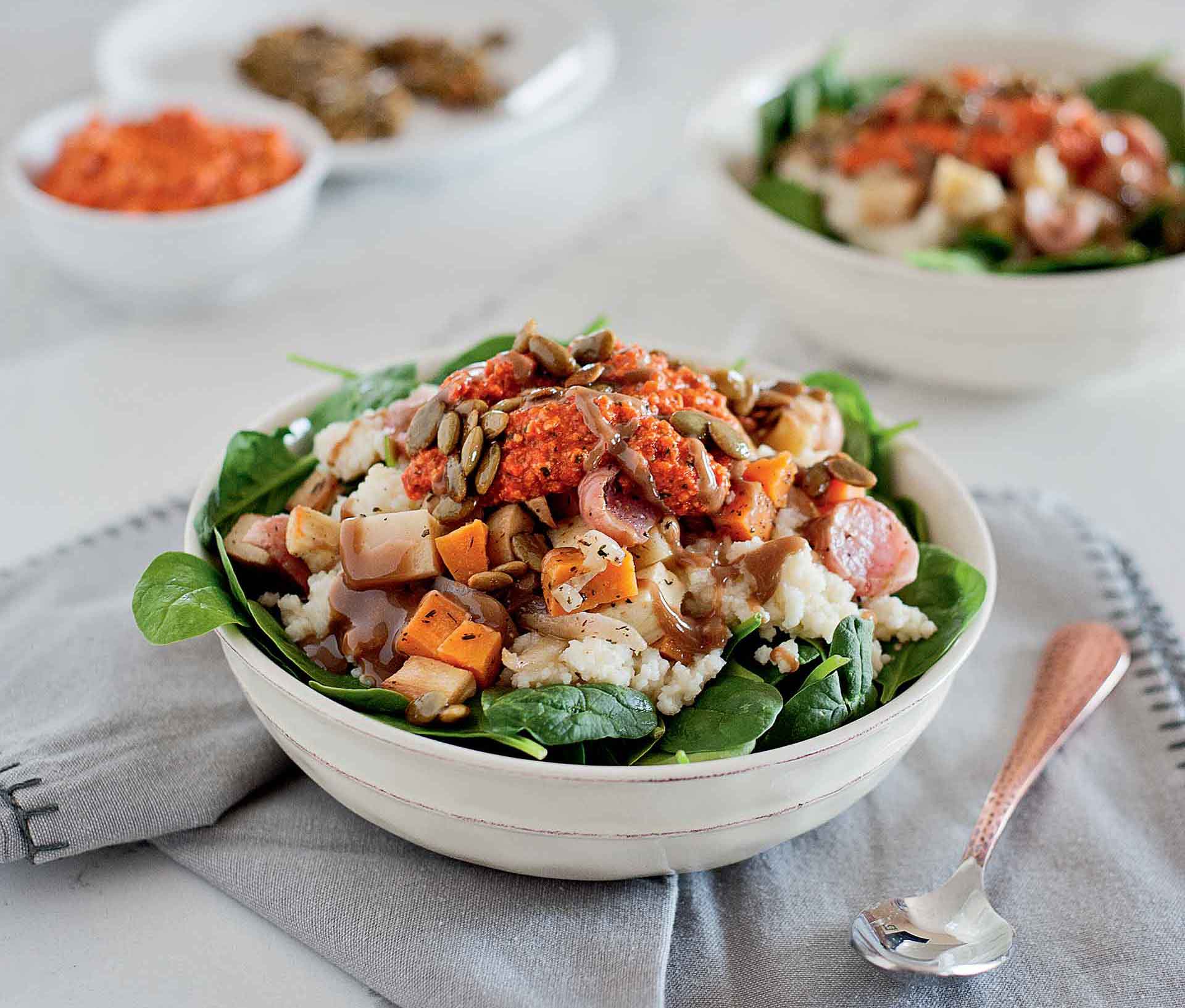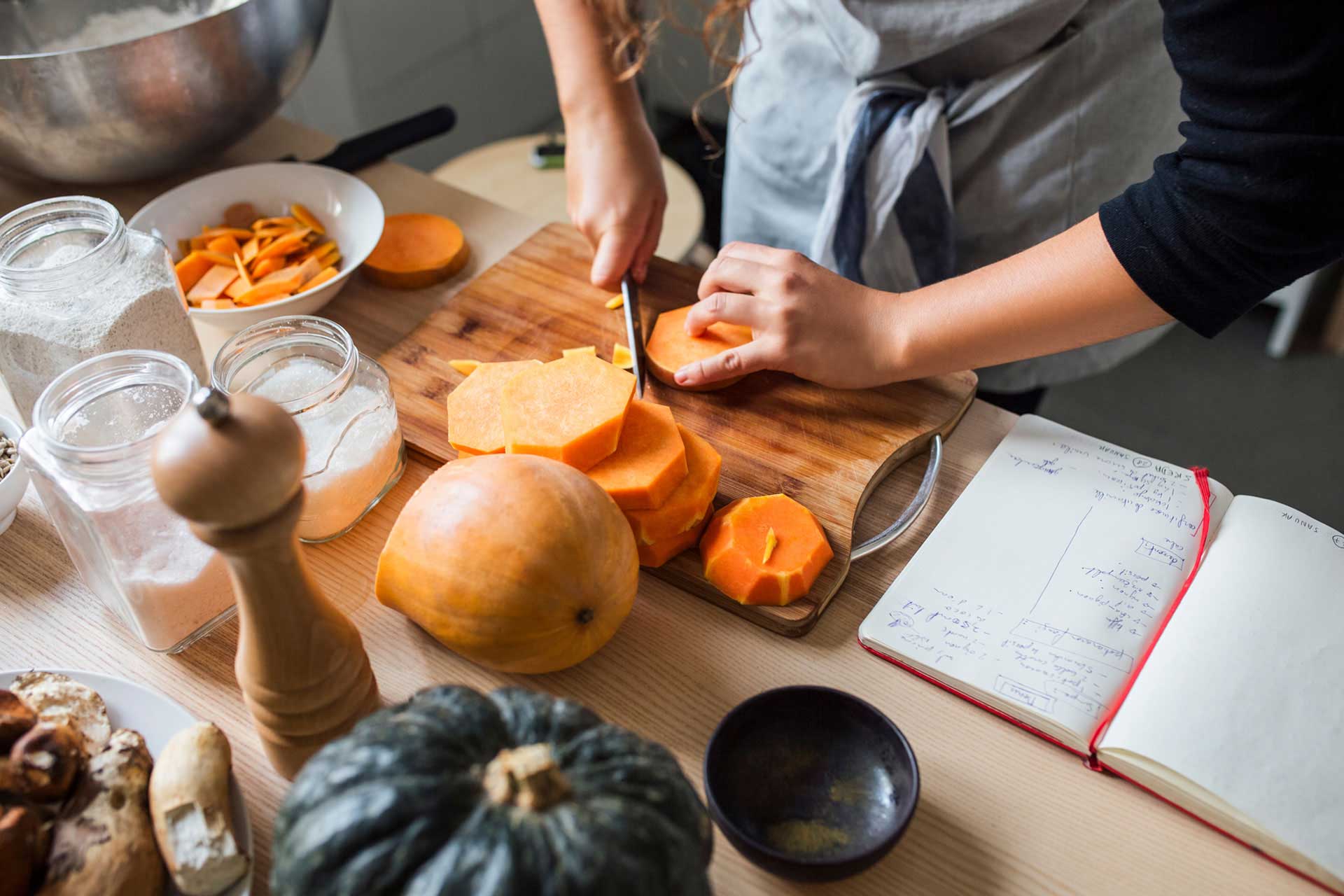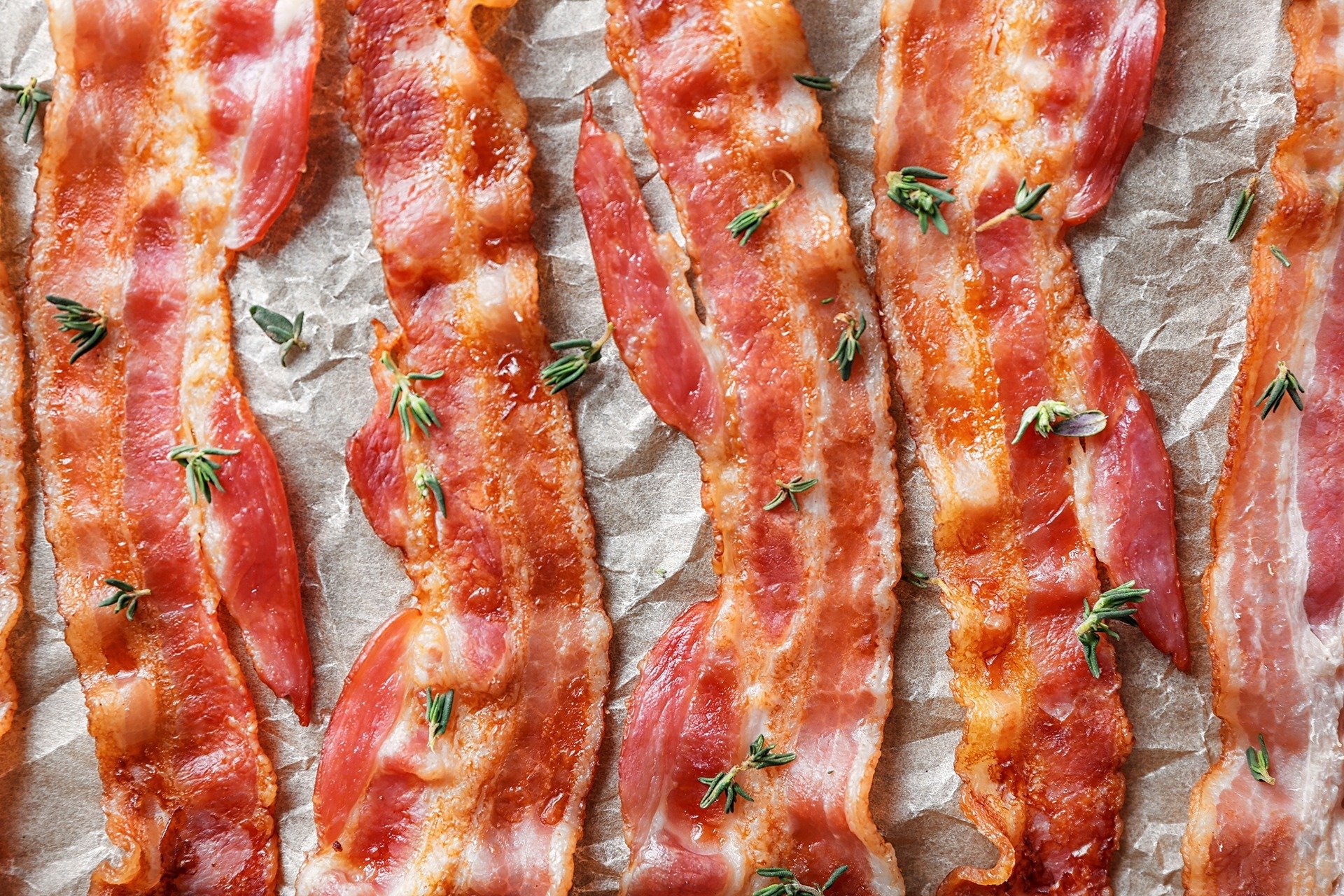Our 10 Favorite Vegetarian Cookbooks
As a former chef and food editor, I don’t lean heavily on cookbooks (vegetarian or otherwise). While I love looking over the gorgeous glossy photos of new cookbooks or following the sage advice of classics, I mostly cook from the hip, gleaning inspiration from cookbooks and then hitting the kitchen on my own.
But when I saw a preview for the new “The Meatless Monday Family Cookbook: Kid-Friendly, Plant-Based Recipes” cookbook, out next month, it got me thinking about my favorite vegetarian cookbooks. As a vegetarian teenager, it was “The Italian Vegetarian Cookbook” (I dreamed about the polenta on the book’s cover.) In college, I was a big fan of “Cooking the Whole Foods Way,” written by one of my culinary school instructors. As an adult — when my diet shifted to include meat, and then eased its way back to mostly plant-based — my favorites have ranged from books like the science-y “On Food and Cooking” to the wellness-focused “My New Roots.”
Pawing through the pages of the Meatless Monday cookbook reminded me how inspiring vegetarian cookbooks can be — they make me think about using vegetables in ways I don’t necessarily come up with on my own — reminding me why I do love, and sometimes need, a good cookbook. With more than 100 recipes approachable veggie recipes, this one is perfect for both vegetarians and someone looking to cut back on meat. Dishes like sloppy lentil sandwiches and butternut squash mac and cheese are clearly kid-approved, while I’m itching to make the roasted root veggie bowl (recipe below), just the kind of dish I want to eat on cold fall evenings. (Hot tip: roast the vegetables on Sunday night to make Monday’s lunch or dinner that much easier.)
With my favorite vegetarian cookbooks on the brain, I asked the FoodPrint staff to chime in with their favorites as well. Whether you are a burgeoning vegetarian, a Meatless Monday devotee or a veg head for life, any of these books will be a great addition to your cookbook shelf.
“Fresh from the Vegetarian Slow Cooker” by Robin Robertson
Instant pot might be all the rage right now, but smart cooks have been using slow cookers for generations. This classic cookbook came out in 2003, teaching vegetarians how to harness its power to create delicious, fool-proof vegetarian creations, including spicy white bean and sweet potato stew with collards, balsamic-glazed carrots and parsnips, and bell peppers stuffed with couscous and lentils. Our Lead Designer, Samarra Khaja, is a big fan. “I usually make things up when I cook, but when I want a little help, this has always been my favorite go-to cookbook,” she says. “Especially in cooler months, you really can’t go wrong with a slow-cooked meal, only having to clean up one pot when it’s all said and done AND be able to bust out a yummy slow-cooked cobbler dessert and the most fragrant mulled wine beverage, all from the same book!”
“The Moosewood Cookbook” by Mollie Katzen
Before plant-based was a trend and vegetarians were influencers, Mollie Katzen wrote “The Moosewood Cookbook,” and a whole generation was inspired to cook plant-based meals. It’s one of the New York Times’ top 10 best-selling cookbooks of all time, was inducted into the James Beard Foundation Cookbook Hall of Fame and was coined a Cookbook Classic by the International Association of Culinary Professionals. With its colorfully mod cover, the recently published 40th anniversary edition would fit easily on the shelf of a hip LA juice café or a stylish Austin coffee shop, and the recipes still hold up today like they did in 1974. “The Moosewood Cookbook” was my very first vegetarian cookbook and, quite possibly, my very first cookbook!” says FoodPrint’s Director Jerusha Klemperer. “I still refer to it for a whole bunch of classics, and there are hidden simple gems, like lists of ideas for vegetarian sandwiches.”
“The Nimble Cook: New Strategies for Great Meals That Make the Most of Your Ingredients” by Ronna Welsh
We have a secret: some of the best vegetarian cookbooks aren’t vegetarian cookbooks at all. Case in point, “The Nimble Cook,” Ronna Welsh’s waste-free cookbook that happens to be packed with tons of great vegetable-forward recipes.
“I’m one of those omnivores who doesn’t eat much meat. I’m also on a lifelong quest to send as little as possible to the compost or the trash. These must be a couple of the reasons why I took to Ronna Welsh’s new-ish cookbook, “The Nimble Cook,” explains Digital Marketing Manager Lauren Wilson. “Ronna takes an ingredients-first approach that helps you realize their full potential. Pick up some knockout garlic from the market? You’ll even use the skins if you follow her surprising recipe for garlic-skin vinegar. Those celery leaves? They’re now a key ingredient in your new-favorite spicy slaw with a little fennel, lemon and onion. You’ll be so busy experimenting with grains, fruits and vegetables that you won’t even crack open the (relatively short) meat section of the book.”
“Plenty” by Yotam Ottolenghi
Is there a hip, vegetarian cook that isn’t familiar with these eggplants? When the “Plenty” cookbook came out in 2011, the cover — and its now-iconic roasted eggplant, drenched in buttermilk sauce and pomegranate seeds — was everywhere: bookstores, beauty shops, clothing stores, cafes. And with good reason. Chef Yotam Ottolenghi brought the bright, fresh Mediterranean flavors from his London restaurants into this book’s recipes and home cooks were forever changed, adding barberries, sumac and pomegranate molasses into their pantries and cooking flavorful vegetables without missing the meat.
“Ruffage” by Abra Berens
When I picked up Abra Berens’ cookbook “Ruffage” earlier this year, I knew I had a keeper. As a chef, farmer and home cook, Berens offers the best of advice on produce shopping, storage and cooking. And, as she acknowledges that not everyone is comfortable cooking vegetables, her goal is to make things as accessible as possible.
As I wrote on FoodPrint back in May, “[Berens] gets that vegetables can be intimidating and making an entire meal out of them, downright dumbfounding… To help all the confused-by-veggies cooks out there, she’s put together 100 practical recipes (along with numerous variations on each). It’s weeknight cooking that highlights produce’s natural flavor, without too much fuss.” It doesn’t hurt that her recipes are also delicious, the kind that have stuck in my head; when I’m wandering through a supermarket deciding what to make for dinner, I often think of a recipe from “Ruffage.” (In fact, I’m making her braised celery tonight.) One of the newer books on this list, Berens has quickly earned a spot on my cookbook all-stars. Want a preview of “Ruffage?” We’ve got the book’s recipe for blistered cucumbers and yogurt sauce.
Six Seasons: A New Way with Vegetables by Joshua McFadden
Back when I was a food editor at Epicurious, our cookbook club chose “Six Seasons” to feature one month, and I’ve been a fan ever since. The reason: cooked salad. Joshua McFadden is a genius with vegetables, and that recipe, which broils firm bitter greens, such as radicchio, with a bit of cheese to create a warm salad that’s perfect for chilly winter days, is a great example.
Lauren agrees with me. “I think this cookbook’s super power is how it brightens up winter produce,” she says. “Yes, it’s difficult to imagine how you might cook turnips for the umpteenth time come February, but with ingredients you most likely already have in your pantry, McFadden builds bold flavors with simple techniques. Take his lasagna, for example. Adding heaps of lemon zest to the ricotta balances the hearty bechamel and complements the kale and mushrooms. I highly recommend it for the coldest, wettest, darkest of winter days.”
“Vegan Soul Kitchen” by Bryant Terry
Taking things vegan doesn’t mean taking out flavor when it comes to Bryant Terry’s first cookbook “Vegan Soul Kitchen,” a collection of plant-based, farm-to-table recipes that reimagine soul food without the heavy salt and refined sugar, “bad” fats and unhealthy cooking techniques. But this is no health food cookbook. Terry — a chef and food activist who works to create a healthy, just and sustainable food system — looked to the culinary history of the of the African Diaspora to create his recipes, drawing on the staples and cooking techniques of African, Caribbean, African-American, Native American and European cuisines in dishes like double mustard greens and roasted yam soup, Cajun-Creole-spiced tempeh pieces with creamy grits, and sweet cornmeal-coconut butter drop biscuits.
“Vegetables from an Italian Garden: Season-by-Season Recipes” by the editors of Phaidon Press
Another book on our list that isn’t totally vegetarian, but that totally inspires us, “Vegetables from an Italian Garden,” is almost like a picture book for cooking. With bring, vivid imagery, it sweeps your imagination away with the flavors and textures of the vegetables you could be cooking up all year round.
“My family are members of a CSA and love to eat what’s in season. We found “Vegetables from an Italian Garden” a few years back, which is dreamily divided by spring, summer, fall and winter,” says former FoodPrint Policy Analyst Maggie Tauranac. “We don’t eat meat in the house, and while the cookbook isn’t entirely vegetarian, it is vegetable-focused and has plenty for the veggie-inclined. Alas, we don’t live in Italy or have a garden, but the book gives us sublime inspiration for cooking whatever comes in our CSA share throughout the year, which allows us to pretend we do.”
“Vegetarian Cooking for Everyone” by Deborah Madison
A grand dame of vegetarian cuisine, every vegetarian cook — and every cook for that matter — should have a Deborah Madison cookbook on their shelf. Madison has published 14 cookbooks, and “Vegetarian Cooking for Everyone” is easily one of the most popular vegetarian cookbooks ever published.
“I have long been a huge fan of Deborah Madison’s “Vegetarian Cooking for Everyone.” It’s a tome, but it’s utterly unintimidating, organized alphabetically to take you through vegetables both familiar and new,” Jerusha explains. “I am still finding new treasures in it, after over a decade. My favorite part is that to the side of each recipe is a quick note from Deborah about why she likes this recipe or what it tastes great with. It’s fun to pair with a CSA share, ensuring you have at least one recipe for that kohlrabi or bok choy you just got and are staring at, quizzically.” And FYI, Madison has just released an updated and expanded edition of the book, “The New Vegetarian Cookbook for Everyone.”
“World Vegetarian” by Madhur Jaffrey
There are icons, and then there are cookbooks authors like Madhur Jaffrey. While she is the queen of Indian eats (her first cookbook Madhur Jaffrey’s “World of the East Vegetarian Cooking” helped make her name, and I can’t recommend enough her memoir about growing up in India, “Climbing the Mangoes Trees”), “World Vegetarian” is such an extensive and thorough cookbook, it’s a must for the vegetarian cookbook shelf. Jaffrey travels the globe through 650 recipes, inviting readers to cook from continent to continent. This expert cook offers something for everyone in this tome, with dozens of recipes for beans, lentils, vegetables, dairy, grains and more.

Recipe: Roasted Winter Vegetable Bowls with Couscous, Romesco Sauce, and Tahini Drizzle
Jenn Sebestyen, “The Meatless Monday Family Cookbook: Kid-Friendly, Plant-Based Recipes”
Yield: 4 servings
This is one of my favorite recipes in this book. The combination of flavors and textures exceeded my expectations, and now I find myself craving a big bowl. It may seem like a lot of steps, but they are all easy and can basically be done at the same time. The romesco sauce can be made ahead of time and kept in the fridge. Have the kids whisk up the dressing to save you one extra step.
Ingredients
For the roasted vegetables:
2 sweet potatoes, peeled and chopped into 1-inch (2.5 cm) cubes
2 parsnips, peeled and chopped into 1-inch (2.5 cm) cubes
8 radishes, halved or quartered if large
1 red onion, halved and sliced
1 tablespoon (15 ml) olive oil
1 teaspoon dried thyme
¼ teaspoon salt, or to taste
⅛ teaspoon black pepper, or to taste
For the couscous:
1½ cups (355 ml) water
1 teaspoon olive oil
¼ teaspoon salt, or to taste
1 cup (175 g) dry couscous
For the spicy toast pumpkin seeds:
½ cup (70 g) raw shelled pumpkin seeds
1 teaspoon olive oil
1 teaspoon pure maple syrup
¼ teaspoon cayenne
¼ teaspoon garlic powder
For the tahini drizzle:
⅓ cup (80 g) tahini
1 tablespoon (20 g) pure maple syrup
1 tablespoon (15 ml) balsamic vinegar
For the bowls:
4 cups (120 g) baby spinach
1 recipe Romesco Sauce (page 166)
1 recipe Tahini Drizzle (see below)
2–4 tablespoons (28–60 ml) water, to thin
Method
For the Roasted Vegetables: Preheat the oven to 400°F (200°C, or gas mark 6). Line a rimmed baking sheet with parchment paper and set aside.
Place all the ingredients in a large mixing bowl and toss well. Spread out onto the prepared baking sheet in one even layer. Roast for 15 minutes, stir vegetables and spread back out in one even layer and then roast for 10 to 15 minutes more.
For the Couscous: Bring the water to a boil, turn off the heat, and add the olive oil and salt. Pour in the couscous and let it sit for 5 to 10 minutes. When all the water is absorbed, fluff with a fork. Stirring with a spoon may create clumps; a fork is best here.
For the Spicy Toasted Pumpkin Seeds: Line a small plate with parchment paper and set aside. Heat the olive oil, maple syrup, cayenne, and garlic powder in a small skillet over medium heat, stirring gently. When you start to see it sizzling, add the pumpkin seeds. Stir frequently until the seeds are toasted, about 4 to 5 minutes. Transfer the pumpkin seeds to the prepared plate. They will continue to crisp up as they sit.
For the Tahini Drizzle: Add the tahini, maple syrup, and balsamic vinegar to a small bowl. Stir to combine. Add water 1 tablespoon (15 ml) at a time until desired consistency is reached.
To assemble the bowls: Place 1 cup (30 g) of baby spinach in a bowl, top with one-quarter of the couscous, one-quarter of the roasted vegetables, a generous dollop of Romesco sauce, 2 tablespoons (18 g) of Spicy Toasted Pumpkin Seeds, and a tablespoon or two of Tahini Drizzle.
TIP: While the vegetables are roasting, you can make all other components of the dish so that everything is ready to go when the vegetables are done.
NOTE: Don’t be afraid of the cayenne in the Spicy Toasted Pumpkin Seeds. The seeds will taste spicy right out of the skillet, but when eaten with the other bowl ingredients, the flavors will complement each other and tone down the spiciness.
Swap It!
Make this dish gluten-free by using 1 cup (173 g) of quinoa, cooked according to package directions, in place of the couscous.
Recipe: Romesco Sauce
Jenn Sebestyen, “The Meatless Monday Family Cookbook: Kid-Friendly, Plant-Based Recipes”
Yield: about 3 cups (700 ml)
This sauce is like a pesto in texture but made with peppers. Many versions are thickened with leftover bread, but here I’m using panko bread crumbs because they’re a pantry staple and they help create that wonderful pesto-like texture. My version is smoky and a little sweet, and it pairs well with a variety of dishes. Try it on pasta or rice. Use it as a dip for garlic bread or quesadillas or simply drizzle it over roasted vegetables.
Ingredients
1 jar (12 ounces, or 340 g) roasted red peppers, drained
1 can (15 ounces, or 425 g) fired roasted diced tomatoes, drained
½ cup (73 g) raw almonds
¼ cup (13 g) panko bread crumbs or regular bread crumbs
2 cloves garlic
1 tablespoon (7 g) smoked paprika
½ teaspoon salt, or to taste
1 tablespoon (15 ml) balsamic vinegar
Method
Place all the ingredients in a food processor. Process until mostly smooth. It should resemble a pesto in texture, so it won’t be totally smooth.
First Published in 2019 by Fair Winds Press, an imprint © 2019 Quarto Publishing Group USA Inc.
Text © 2019 Jenn Sebestyen
Get the latest food news, from FoodPrint.
More Reading
How to host a sustainable dinner party
December 16, 2025
Tradwives, MAHA Moms and the impacts of "radical homemaking"
December 10, 2025
The FoodPrint guide to beans: Everything you need to know to buy, cook, eat and enjoy them
November 18, 2025
Your guide to buying and preparing a heritage turkey or pastured turkey this Thanksgiving
November 18, 2025
How Miyoko Schinner upped the game for vegan dairy
November 7, 2025
30+ things to do with a can of beans
November 4, 2025
In a beefy moment, beans?
November 4, 2025
Waste not, want not with “Ferment,” a new cookbook by Kenji Morimoto
October 1, 2025
For these cocoa farmers, sustainability and the price of beans are linked
September 17, 2025
You haven’t had wasabi until you’ve had it fresh — and local
September 11, 2025


